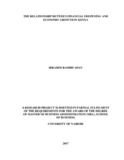| dc.description.abstract | Financial theories have emphasized the need to increase savings through deepening of financial markets so as to stimulate investments for improved economic growth. This has led to the expansion of financial sector providers to include microfinance institutions among others to ensure that the depth of financial systems is commensurate. The study sought to determine the extent to which changes in economic growth could be explained by changes in the level of financial depth. The level of financial depth was measured by the extent of credit to private sector, market capitalization and broad money in the economy. In order exhaustively respond to study objective, the study adopted a descriptive research design because it is best suited in illustration of characteristics of a study phenomenon. This was because the study sought to study the phenomenon as they were without manipulating them. Descriptive designs were concerned with establishing the what, when, where, how and whom of a phenomenon so that more information was availed which helped in building a profile. This study used secondary data. Secondary data is defined as the data which has already been collected and used for other purposes other than for the sole purpose of the current study. This study collected secondary data on study variables from the Central Bank of Kenya, Kenya National Bureau of Statistics and World Bank website for the period 200 to 2016. Data on market capitalization was collected from the Nairobi Securities Exchange annual Handbook Manual. The study used descriptive and inferential statistics in estimating the extent to which changes in the independent variables affected the dependent variable. Specifically, the descriptive statistics included mean, skewness, and kurtosis, median, lowest and highest values. Analyzed data was presented in tables and charts. The study established that the Model summary indicated an R of 0.936 showing that financial deepening showed a strong positive relationship with economic growth in Kenya. The ANOVA results show that the overall regression model was a significant predictor of the relationship between the variables of the study. The p value 0.002<0.05 further supports the argument of significance. From correlation analysis, broad money had a Pearson correlation of -0.159 with p value was 0.002. Private credit sector had a Pearson correlation of 0.893 with p value 0.000 and market capitalization had a Pearson correlation of 0.846 with p 0.001 which is less than 0.05. The study concluded that private sector credit and market capitalization had p values less than 0.05 and therefore significant indicators of economic growth. The study recommends that the Central Bank of Kenya should instill sound fiscal and monetary policies for regulating the level of inflation and supply of money in the economy. The national government should encourage private sector participation and involvement in economic development by providing conducive and favorable economic environments. | en_US |



